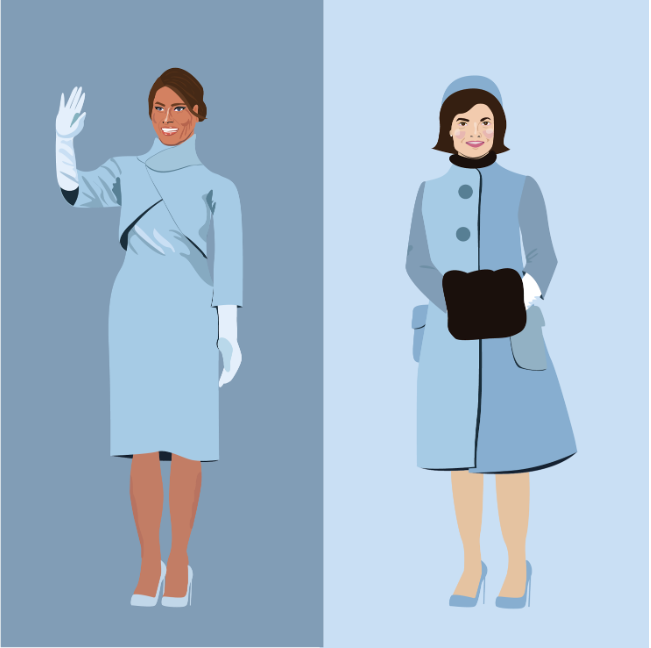Why We Need To Keep An Eye On The Politics of Fashion

Emma Hager
8 March 2017
8 March 2017
That the personal is political is a hackneyed, albeit it endlessly useful, statement. One can use it quite easily to encompass the still-pressing concerns of reproductive rights, racial justice, and so on. And in this way, it seems somewhat trite to apply it to anything in the sartorial realm. We’re in the midst of some sort of populist overhaul, in which a historical nostalgia — open and pleasant and welcoming to so few — has become the mood for a nation it does not reflect. There is, too, a deep skepticism towards scientific advancement. I could go on, but the tension, or question, seems to be: who, in their right minds, could care about designers at a time like this?
The truth is, we should and we do. Fashion has always been used to send messages, and fashion has always been a diplomatic tool. Clothes can be a means of gauging national unity. Just think of the purple lapels on Hillary Clinton’s November 9th concession speech pantsuit, which, in their hue, encompassed the red of the republicans and the blue of the democrats, in a simple gesture towards the notion that she still believed, per her campaign slogan, we are ‘stronger together.’
Michelle Obama, during her time as First Lady, relied frequently and strategically on her clothes to reinforce the themes of her husband’s administration, and of the broader political climate. At a final state dinner wherein Italy’s former Prime Minister, Matteo Renzi and his wife, Agnese Landini, were guests of honor, Mrs. Obama chose to wear a metallic Versace dress. This choice, yet again, a sign of international alliance.
So the question now becomes what, exactly, we are supposed to make of Melania Trump’s choices. Nearly a month into the Trump presidency and Mrs. Trump has remained largely out of sight and with no real rollout of her in-office missions. Rumors swirl that Trump feels unprepared and daunted by her new and public task. I would argue that this was reflected in the powder-blue ensemble she wore to the inauguration. The look — a Ralph Lauren wool shift dress with matching gloves and a bolero-like top — was iterative of Jackie Kennedy’s style. On one hand, you could write it off as an elegant and timeless nod to First Ladies Past. But in this sartorial mockery, Mrs. Trump seemed to become a caricature of her new role, taking from a limited playbook and reflecting back an uncertainty about how she may go about defining the title in her own and original way — or if she will do so at all.
Clothes aren’t everything, or even the half of it. They cannot solve issues of diplomacy. But what they can do is highlight the triumphs or anxieties of our political climate and the people who dominate it. And for
The truth is, we should and we do. Fashion has always been used to send messages, and fashion has always been a diplomatic tool. Clothes can be a means of gauging national unity. Just think of the purple lapels on Hillary Clinton’s November 9th concession speech pantsuit, which, in their hue, encompassed the red of the republicans and the blue of the democrats, in a simple gesture towards the notion that she still believed, per her campaign slogan, we are ‘stronger together.’
Michelle Obama, during her time as First Lady, relied frequently and strategically on her clothes to reinforce the themes of her husband’s administration, and of the broader political climate. At a final state dinner wherein Italy’s former Prime Minister, Matteo Renzi and his wife, Agnese Landini, were guests of honor, Mrs. Obama chose to wear a metallic Versace dress. This choice, yet again, a sign of international alliance.
So the question now becomes what, exactly, we are supposed to make of Melania Trump’s choices. Nearly a month into the Trump presidency and Mrs. Trump has remained largely out of sight and with no real rollout of her in-office missions. Rumors swirl that Trump feels unprepared and daunted by her new and public task. I would argue that this was reflected in the powder-blue ensemble she wore to the inauguration. The look — a Ralph Lauren wool shift dress with matching gloves and a bolero-like top — was iterative of Jackie Kennedy’s style. On one hand, you could write it off as an elegant and timeless nod to First Ladies Past. But in this sartorial mockery, Mrs. Trump seemed to become a caricature of her new role, taking from a limited playbook and reflecting back an uncertainty about how she may go about defining the title in her own and original way — or if she will do so at all.
Clothes aren’t everything, or even the half of it. They cannot solve issues of diplomacy. But what they can do is highlight the triumphs or anxieties of our political climate and the people who dominate it. And for

